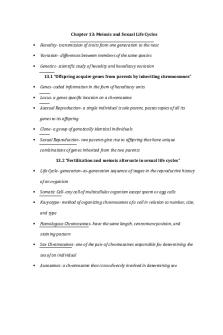Chapter 13- Evolution - Summary Campbell Biology Concepts and Connections PDF

| Title | Chapter 13- Evolution - Summary Campbell Biology Concepts and Connections |
|---|---|
| Course | Foundations Of Biology |
| Institution | Cornell University |
| Pages | 3 |
| File Size | 45.3 KB |
| File Type | |
| Total Downloads | 99 |
| Total Views | 198 |
Summary
Chapter summary on evolution....
Description
Fossils- imprints or remains of organisms that lived in the past • Footprints, burrows, an d fossilized feces provide evidence of an ancient organisms behavior • New layers of sediment cover old ones and compress them into layers of rock called strata ◦ The fossils in a particular stratum suggest which organisms lived in the area at the time the layer formed ◦ Because younger strata are on top of older ones, the relative ages of fossils can be determined • Similarity resulting from common ancestry is called homology • Homologous structures: features that have different functions but are structurally similar due to common ancestry •
The greater the number of sequence distance between species, the the more distant is their last common ancestor
• Vestigal structures- remnants of features that served important function in an organisms ancestors • Pseudogenes- genes that have lost their function and are inactive • Evolutionary trees show patterns of descent Artificial selection has two essential components: variation and heritability • Variation allows a breeder to select the organisms with the most desirable combination of characters as breeding stock for the next generation • Heritability is the transmission of a trait from parent to offspring • Individuals do not evolve, populations do • New alleles originate by mutation- a change in the genetic information encoded in the nucleotide sequence of DNA ◦ Only mutations in gamete producing cells can be passed to offspring and affect a populations genetic variability • Population- a group of individuals of the same species that live in the same area and can potentially interbreed • Gene pool- all copies of every type of allele at every locus in all members of the population • Microevolution- a small change in gene pool
Hardy-Weinburg Equilibrium • p + q = must always be 1 • P and q represent allele frequencies (ex: W and w) •
p^2 + 2pq + q^2 = 1 (like a punnet square)
• The three main causes of evolutionary change are natural selection, genetic drift, and gene flow • Natural selection • Genetic drift: chance events can cause allele frequencies to fluctuate unpredictably from one generation to the next (effects smaller populations more than larger ones) ◦ Bottleneck effect: when the size of a population shrinks and certain alleles are present at a higher frequency than others ◦ Founder effect- the smaller a new population, the less likely that their genetic makeup will represent the gene pool of the larger population they left • Gene flow: the way in which a population may gain or lose alleles when fertile individuals move into or out if a population or when gametes are transferred between populations • Relative fitness- the contribution and individual makes to the gene pool of the next generation relative to the contributions of other individuals • Directional selection- shifts the overall makeup of the population by acting against individuals at one of the phenotypic extremes (ex; the darkest coated organism survives) • Stabilizing selection- favors intermediate phenotypes; removes extreme phenotypes and maintains the statusquo for a particular character • Disruptive selection- favors phenotypes at opposite ends; favors extreme phenotypes, leading to two or more contrasting phenotypes in the same population • Balancing selection- occurs when natural selection maintains stable frequencies of two or more phenotypic forms in a population • Heterozygote advantage- a type of balancing selection in which heterozygous individuals have greater reproductive success than either type of homozygote, with the result that two or more alleles for a gene are maintained in the population •
Lecture Notes More offspring are produced than can survive and reproduce...
Similar Free PDFs

Ch26 - Summary Campbell Biology
- 6 Pages
Popular Institutions
- Tinajero National High School - Annex
- Politeknik Caltex Riau
- Yokohama City University
- SGT University
- University of Al-Qadisiyah
- Divine Word College of Vigan
- Techniek College Rotterdam
- Universidade de Santiago
- Universiti Teknologi MARA Cawangan Johor Kampus Pasir Gudang
- Poltekkes Kemenkes Yogyakarta
- Baguio City National High School
- Colegio san marcos
- preparatoria uno
- Centro de Bachillerato Tecnológico Industrial y de Servicios No. 107
- Dalian Maritime University
- Quang Trung Secondary School
- Colegio Tecnológico en Informática
- Corporación Regional de Educación Superior
- Grupo CEDVA
- Dar Al Uloom University
- Centro de Estudios Preuniversitarios de la Universidad Nacional de Ingeniería
- 上智大学
- Aakash International School, Nuna Majara
- San Felipe Neri Catholic School
- Kang Chiao International School - New Taipei City
- Misamis Occidental National High School
- Institución Educativa Escuela Normal Juan Ladrilleros
- Kolehiyo ng Pantukan
- Batanes State College
- Instituto Continental
- Sekolah Menengah Kejuruan Kesehatan Kaltara (Tarakan)
- Colegio de La Inmaculada Concepcion - Cebu














